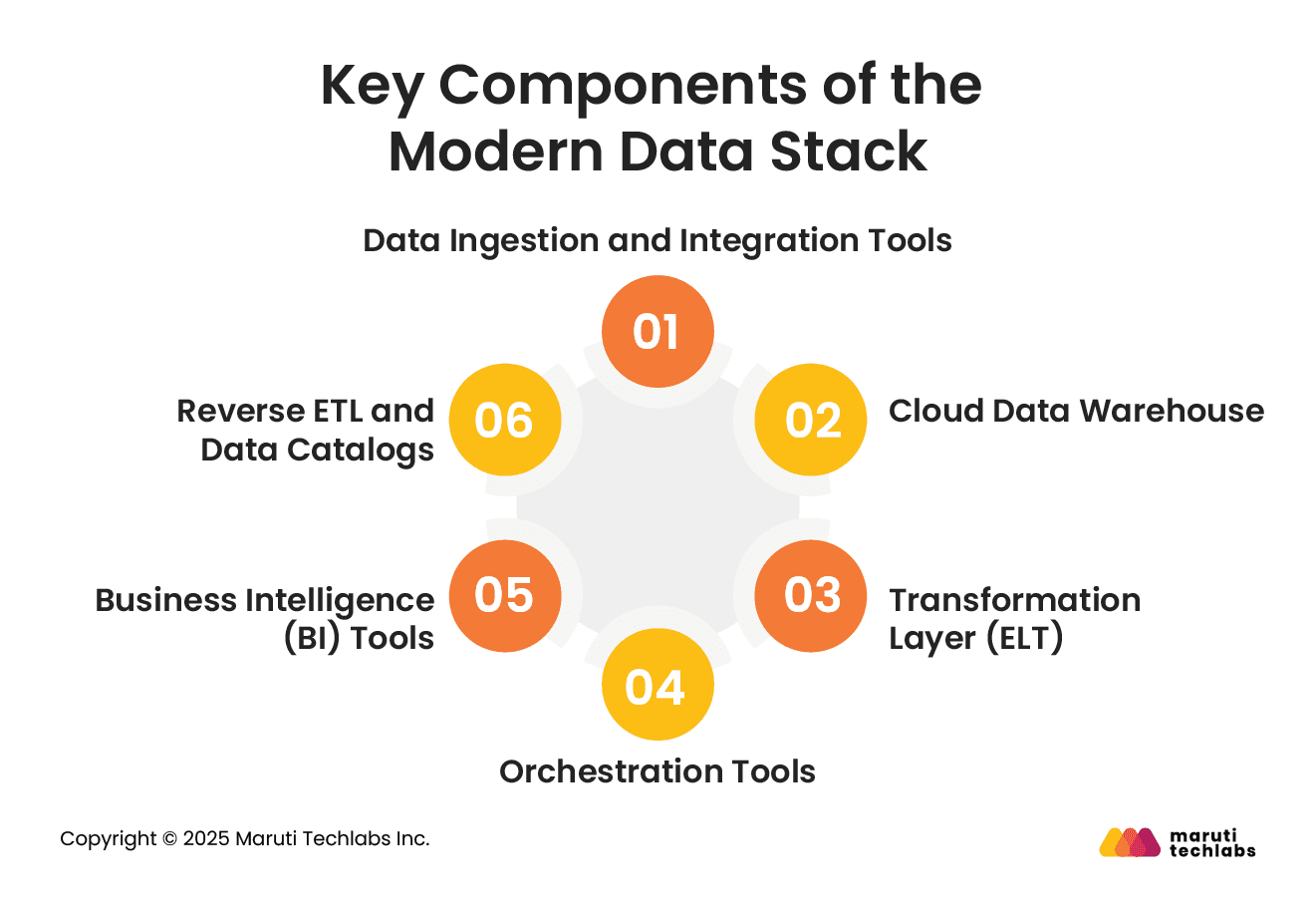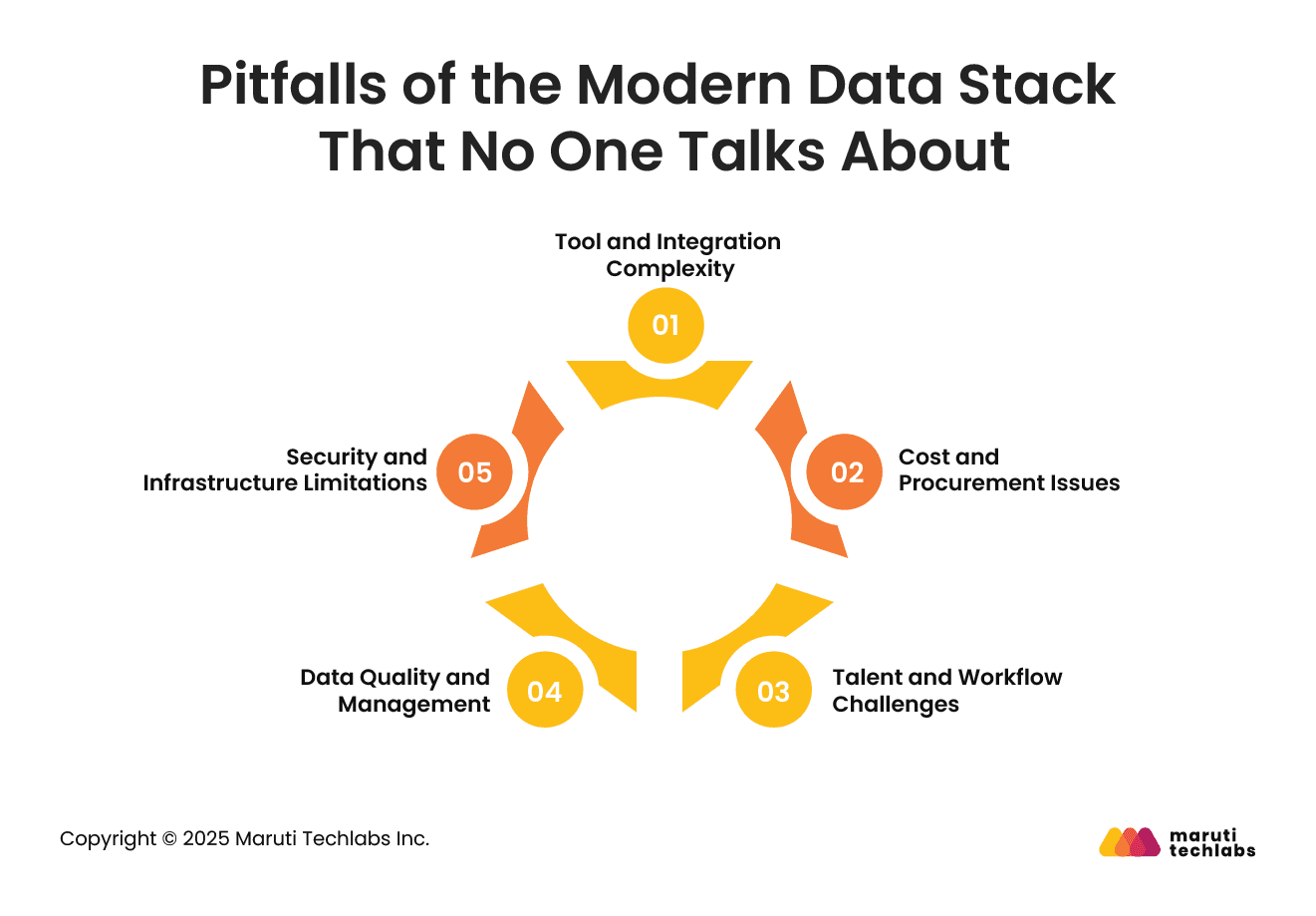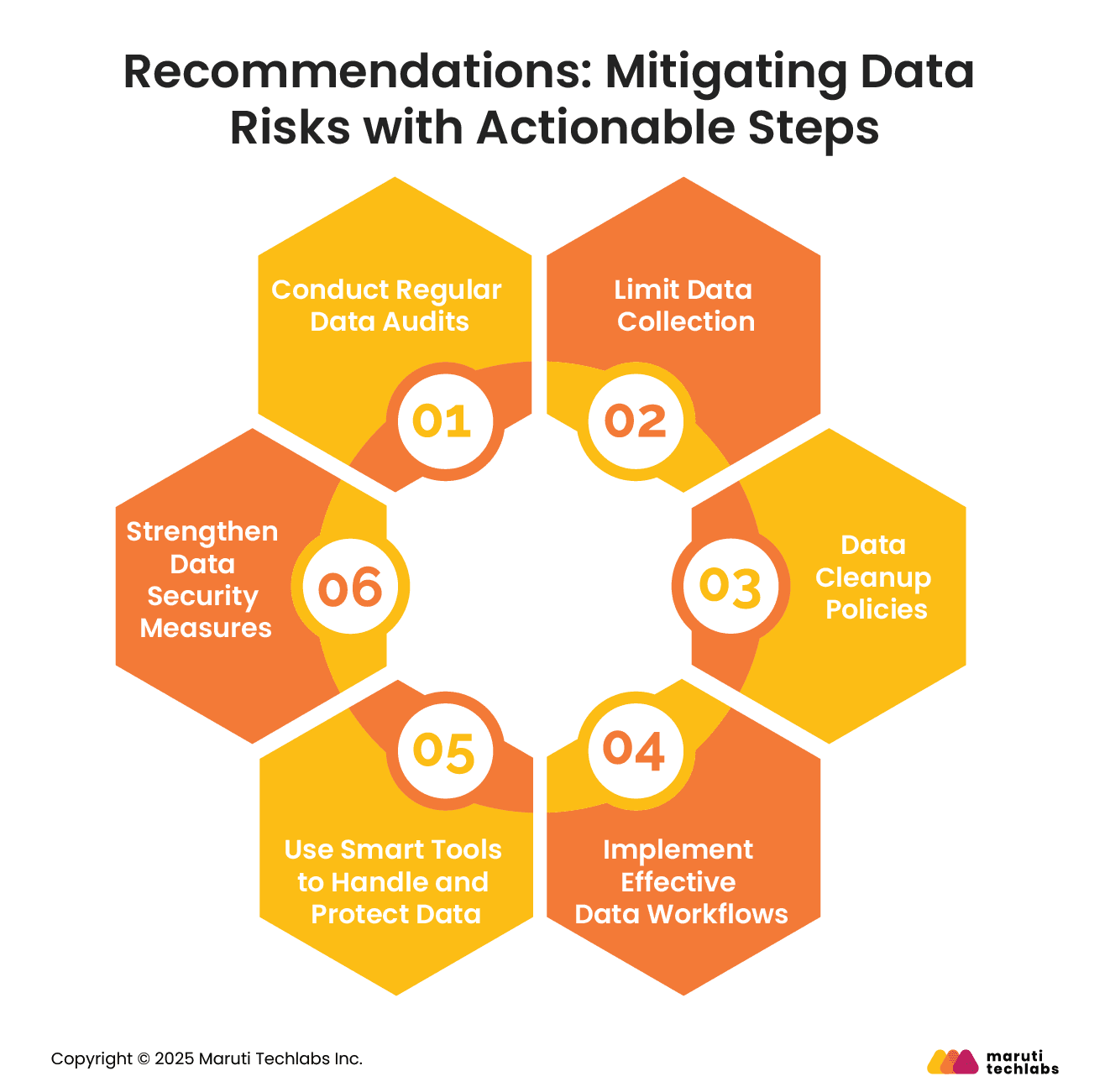

The Ultimate Guide to Navigating Modern Data Stack Pitfalls






Over the past decade, data has become one of the most valuable assets for any organization. Business experts across industries have been urged to collect everything—customer interactions, operational metrics, financial logs, and more—promising that data would unlock growth, innovation, and competitive advantage. And many did just that. But today, those same businesses are overwhelmed.
With dozens of tools, platforms, spreadsheets, and siloed systems generating data every second, the challenge has shifted from collection to usability. It's no longer about how much data you have—it's about whether you can do anything with it. For many, the answer is no.
Analysts spend more time preparing data than analyzing it. Business teams wait days or weeks for insights. Despite having more information than ever before, decision-making is still slow, fragmented, and reactive. This growing gap between data potential and usability has forced organizations to rethink how they manage, process, and act on their data. This is where a modern approach designed for flexibility, scalability, and real-time insights becomes essential.
In this blog, we’ll explore the modern data stack, why it’s so widely adopted, the hidden challenges it presents, and practical ways to overcome them.
The modern data stack is the go-to setup for organizations that rely heavily on data to make decisions. At its core, the modern data stack is just a smarter way of handling data. Instead of relying on old-school systems that are slow and hard to manage, companies now use a mix of cloud tools that help bring in data, clean it up, store it, and make it easy to analyze, all without the heavy lifting that used to be involved.
Its popularity has grown as more companies move to the cloud and face the challenge of managing huge volumes of data. Teams want fast insights without needing to build everything from scratch, and the modern data stack makes that possible. It’s also modular, meaning you can pick and choose the tools you need instead of being locked into one big system.
The following are a few key components of the modern data stack:

These tools help bring raw data from different sources, such as apps, databases, or third-party platforms, to a central location. Think of them as the pipes that carry data into your system.
Once the data is in, it needs a place to live. Cloud data warehouses like Snowflake, BigQuery, or Redshift store the data and make it easy to query at scale.
This is where the raw data is cleaned, organized, and reshaped into something useful. ELT (Extract, Load, Transform) tools handle this step efficiently inside the warehouse.
These tools coordinate the flow of data between systems, ensuring that tasks occur in the right order and on schedule.
BI tools let users explore the data, build dashboards, and create reports. These are often the most visible part of the stack.
Reverse ETL tools push insights back into business tools (like CRMs), while data catalogs help teams find and understand their data.
Together, these tools form a streamlined, cloud-native way to work with data, helping organizations move faster, make smarter decisions, and stay competitive.
The modern data stack has become the go-to approach for building scalable, cloud-based data infrastructure. It promises flexibility, faster development, and a modular architecture. But behind the buzzwords and vendor claims lie several practical issues that teams often discover only after adoption. Here’s a closer look at the challenges many don't talk about:

As the number of tools grows, keeping them aligned and easy to manage becomes a real challenge.
As the ecosystem grows, teams often end up using multiple tools that serve similar functions. This creates redundancy and confusion and often leads to teams not fully using what they've purchased. Choosing the right tool becomes a burden, and switching later is even harder.
Contrary to the promise of "plug-and-play," configuring and integrating various tools still requires a lot of effort. It involves setting up data connectors, managing dependencies, and resolving compatibility issues across the stack. Every tool added means more ongoing updates, vendor communications, and troubleshooting.
Each tool comes with its own interface, workflow, and terminology. As users move between tools, they face a lack of consistency that disrupts productivity. Learning and remembering how each system works adds cognitive overhead and slows onboarding.
It is challenging to get different parts of the stack to work in harmony. Without proper end-to-end orchestration, workflows break or stall silently. This lack of automation and central control can lead to delays in data delivery, incomplete processing, and business teams working with outdated information.
Managing costs and vendor relationships gets harder as more tools and contracts enter the picture.
Procurement becomes a maze when dealing with multiple vendors. Teams must negotiate separate contracts, manage different renewal cycles, and handle varying support SLAs. Admin teams often find themselves buried under billing confusion and license tracking.
Modern tools may have friendly-looking pricing on the surface, but real costs add up. You pay for licenses, infrastructure, data storage, support, training, and specialized staffing. The more fragmented the stack, the more expensive it becomes to manage at scale.
Once you’ve built around a particular vendor’s tool, switching is difficult and costly. Many platforms make extracting data hard or require you to pay more to access basic features, making it difficult to pivot or negotiate better terms.
Keeping talent aligned and workflows efficient is increasingly complex as tools become more specialized and teams more siloed.
Despite marketing claims, many tools still require hand-coding for advanced use cases like complex data transformations, machine learning pipelines, or third-party integrations. This increases development time and creates a dependency on engineers.
Modern tools often require specialized knowledge. This puts pressure on hiring managers to find professionals already familiar with niche platforms. With high demand and limited supply, hiring becomes expensive and slow.
When teams rely on different tools and workflows, knowledge becomes siloed within departments. This reduces collaboration, introduces misalignment, and makes the organization overly dependent on specific individuals. When those people leave, knowledge gaps can severely impact productivity.
Managing data quality becomes increasingly complex when systems are disconnected and standards aren’t enforced.
Because data pipelines span across disconnected tools, even a small change in one component can cause silent failures. This fragility makes troubleshooting difficult and introduces delays that affect downstream processes.
Different teams define and model data in different ways, leading to mismatches in metrics, schemas, and definitions. Without shared data modeling practices, trust in reporting and analytics outcomes decreases.
Enforcing data privacy, access policies, and compliance becomes nearly impossible when control is spread across various tools and teams. Data gets used inconsistently, putting the business at risk of regulatory violations.
Without a unified monitoring layer, it’s hard to track where data comes from, how it’s transformed, or where issues lie. You can’t easily answer questions about data lineage, freshness, or quality across the stack.
As the stack grows, so do the risks and limitations tied to security and infrastructure choices.
With data flowing through many platforms, it becomes hard to keep track of where sensitive data lives and who has access. This increases the risk of data leakage, misconfiguration, or malicious activity going unnoticed.
Most modern data stack tools are cloud-native. This is great for some companies, but a limitation for others. Businesses that require hybrid or on-premises deployments for regulatory or cost reasons find themselves boxed into a model that doesn’t work for them.
Managing data isn’t just about collecting it anymore—it’s about ensuring it’s secure, useful, and well-managed. To avoid the issues of a modern data stack, here are some practical steps businesses can take to better handle their data and reduce risks.

1. Conduct Regular Data Audits: Regular data audits ensure that you have a clear understanding of the data you hold. Reviews allow you to assess their relevance, accuracy, and alignment with your business objectives. They also highlight any areas that may need extra care or pose a potential risk.
2. Limit Data Collection: Data minimization is very important for reducing risk. Only collect data for legitimate business purposes and avoid accumulating unnecessary personal information. Storing only what you require reduces the risk of exposing sensitive information and makes it easier to comply with privacy rules.
3. Data Cleanup Policies: It's crucial to define clear policies for how long you'll retain data and when it should be securely deleted. Having clear rules about data retention and secure deletion can help you avoid storing unnecessary information. It also means you can respond quickly to update or correct any data.
4. Implement Effective Data Workflows: Data workflows should be mapped out and maintained to provide transparency across departments. Clear workflows ensure everyone knows how data moves through your organization and who has access to it. This visibility helps prevent unapproved data access and ensures more consistent data quality.
5. Use Smart Tools to Handle and Protect Data: Integrating technology like AI and automation tools can help recognize and protect sensitive data. Automated systems can detect patterns, flag anomalies, and quickly react to potential security threats. Additionally, these technologies help streamline processes and reduce human error.
6. Strengthen Data Security Measures: Robust security measures, including encryption, access controls, and routine security audits, are non-negotiable for protecting your data. Strong security protocols ensure that data is shielded from unauthorized access, tampering, or theft, providing a safer environment for all sensitive information.
When combined, these steps help organizations transform their data challenges into opportunities for greater control, security, and value. By mitigating risks with a structured approach, businesses can ensure their data drives smart decisions rather than becoming a liability.
Modern data stacks promise faster insights and better decisions, but often fall short because they don’t solve the core problem: disorganized, duplicated, and inconsistent data. Before layering on more tools, companies need to focus on cleaning their data foundation and simplifying what they already have. Without that, complexity just multiplies.
One of our clients, a fast-growing marketing tech company, faced challenges with scattered data pipelines and unreliable reporting. Check out how we helped them streamline their architecture, rebuild pipelines from the ground up, and remove redundant tools, making their data stack far more stable, efficient, and easier to maintain.
Is your business coming across similar issues? Connect with Maruti Techlabs for scalable, insight-driven Data Engineering Services.
A traditional data stack often uses on-premise systems and tightly coupled tools, making it harder to scale or adapt. A modern data stack uses cloud-native tools like Snowflake, dbt, and Fivetran that are modular, scalable, and easier to integrate. The key difference is flexibility. Modern stacks let teams move faster, but they also come with risks like tool sprawl and hidden complexity.
Modern data architecture is a way of organizing data systems using cloud technologies. It separates storage, processing, and analytics layers, so teams can plug in tools as needed. It’s built for flexibility, scalability, and real-time insights. Unlike older setups, it supports streaming, machine learning, and data democratization—but only works well if your data is clean and the toolset is well-managed.
Start by defining your data goals and identifying the sources you need. Choose cloud-based tools for ingestion (like Fivetran), storage (like Snowflake), transformation (like dbt), and visualization (like Looker). Keep the setup simple at first—too many tools can cause chaos. Also, focus on data quality, governance, and clear ownership from the start. A thoughtful approach will save time and effort later.
Modern data stack tools are cloud-native software used to collect, store, transform, and analyze data. Popular tools include Fivetran for ingestion, Snowflake or BigQuery for storage, dbt for transformation, and Looker or Tableau for dashboards. These tools are plug-and-play, letting teams scale quickly. However, without a clear strategy, using too many tools can lead to complexity, high costs, and data chaos.


